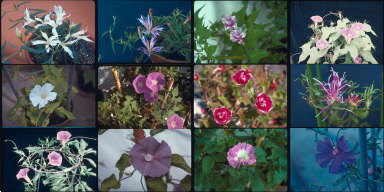Mutant morning glory at the beginning of genetics in Japan
Copyright 1998-2022 Yoshiaki Yoneda
In 1900 the heredity law of Mendel was rediscovered. This new knowledge was introduced into many parts of the world, and the appropriateness of the law was examined immediately by applying it to biological materials of various countries. In Japan, too, the silkworm and the morning glory were used in heredity experiments, both of these being bred and rich in variation in those days. The following references are reports that form the foundation of Japanese genetics.
[Image list] ( Thumbnail images ):
[Name list] ( Name of genes & Gene symbols )
References
- Tanaka, C. (1915) Text-book of Genetics. Maruyamasya-syosekibu, Tokyo.
- Toyama, K. (1916) On some Mendelian characters. J. Jpn. Breeder's Assoc. 1: 1-9.
- Takezaki, Y. (1916) Inheritance of the Japanese morning glory. J. Jpn. Breeder's Assoc. 1: 12-13.
- So, M. and Nishimura, T. (1919) Linkage in morning glory. J. Sci. Agri. Soc. 208:1088-1092.
- Imai, Y. (1919) Genetic studies in morning glories. Bot. Mag., Tokyo 33: 233-260; 273-283.
- Hagiwara, T. (1919) Upon the correlation between two characters of the leaf in the Japanese morning glory. (1). J. Sci. Agri. Soc. 206: 897-901.
- Miyake, K. and Imai, Y. (1920) Genetic experiments with morining glories.1. Bot. Mag., Tokyo 34: 1-26.
- Hagiwara, T. (1920) On the coupling of the leaf-character in the Japanese morning glory. Botan. Mag. (Tokyo) 34: 17-18.
Thereafter, genetic studies on the Japanese morning glory were promoted by Yoshitaka Imai and Tokio Hagiwara. On the other hand, the cultivation of the large flowered morning glory thrived, and, in inverse proportion to this growth, the cultivation of the varied morning glory collapsed in the Taisho (1912-1926) and Showa (1926-1990) eras. After the Second World War, worrying about the scattering of the morning glory seeds that had taken place in the war, Dr. You Takenaka of the National Institute of Genetics tried to collect the morning glory seeds with the cooperation of private cultivators, and to preserve the valuable seeds. The writer started the morning glory study as a member of the Takenaka laboratory, and moved to Shizuoka University in 1969, where some strains of the morning glory were maintained. The many strains preserved over the years at the National Institute of Genetics have been transferred to Kyushu University for preservation currently.

Commentary references about the Japanese morning glory
- Miyake, K. and Imai, Y. (1934) Natural-color illustrated Japanese morning glory. Sanseido.
- Nakamura, C. (1961) Japanese morning glory, its culture and blooming method. Seibunndou-Sinkousya.
- Yoneda, Y. (1977) Morphology of mutants. In: Plant genetics vol.4, Morphogenesis and mutation. (ed.by Kihara and Yamaguchi) p .98-121. Shoukabou.
- Watanabe, Y. (1977) Natural-color illustrated Japanese morning glory; culture method and enjoyment. Nougyoutosho.
- Garden Life (ed.) (1977) Japanese morning glory, culture method and enjoyment. Seibundou Shinkousha.
- Yoneda Y. and Takenaka Y. (1981) Natural-color illustrated monograph of Japanese morning glory. Hokuryukan.
- Ogawa, N. (1981) Photographic collection The varied flowered morning glory in Syouwa-era. Chunichi Shimbunsha.
- Watanabe, Y. (1984) Varied flowered morning glory. Nippon Television Network.
- Yoneda, Y. (1990) Japanese Morning Glory. In: Amirato, P.V., Evans, D.A., Sharp, W.R., Bajaj ,Y.P.S. (eds) 0rnamental Species. Handbook of Plant Cell Culture, Vol 5, pp.509-533, McGraw-Hill Publ. Co., New York.
- Yoneda, Y. (1995) Asagao, a gift from Edo-era: from dreams to science. Syoukabou.
- Yoneda, Y. (1996) Asagao, Ipomoea nil In; Story about experimental biological materials. Heredity 50 (7), 91 ~ 93, Syoukabou.
Edited by Yuuji Tsukii (Lab. Biology, Science Research Center, Hosei University)

